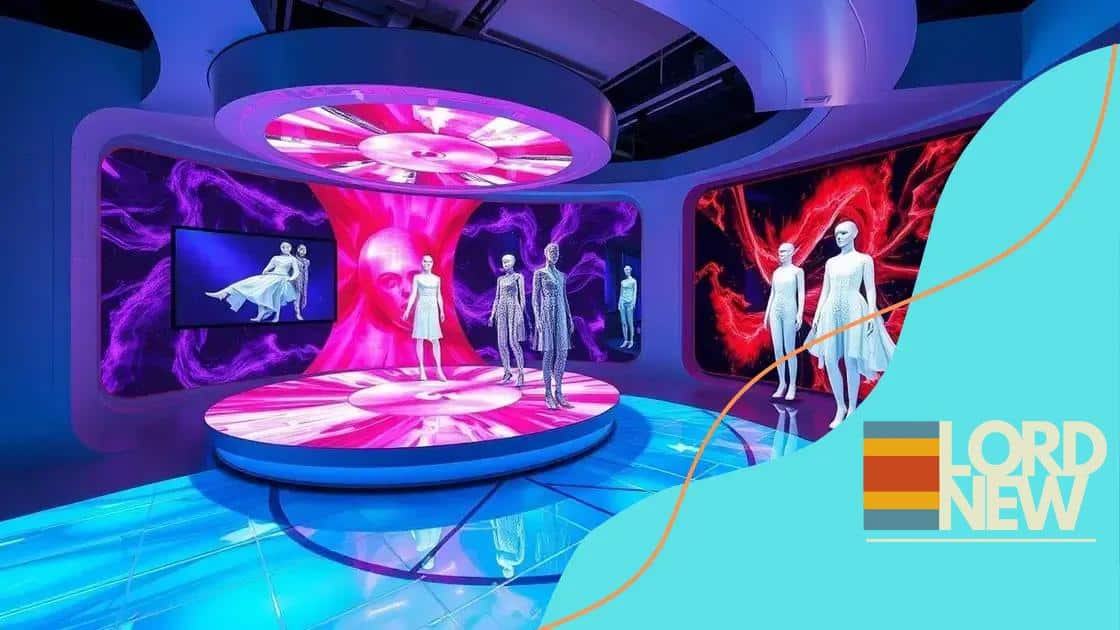Shein’s virtual runway shows and fashion events

Shein’s virtual runway shows and fashion events leverage advanced technology to increase accessibility, engage audiences globally, and create immersive, personalized shopping experiences in the fashion industry.
Shein’s virtual runway shows and fashion events have taken the industry by storm, offering an exciting new way for enthusiasts to engage with fashion. Have you ever wondered how technology can reshape your shopping experience?
What are virtual runway shows?
Virtual runway shows are a groundbreaking way to showcase fashion that brings the excitement of traditional events into the digital age. These events use technology to allow audiences from around the world to experience fashion in a unique and interactive way.
The essence of virtual runway shows
At their core, virtual runway shows combine fashion with innovation. Designers create online presentations to highlight their latest collections, engaging viewers in a new format. This approach not only democratizes access to high fashion but also reshapes how brands connect with their audiences.
Key features of virtual runway shows
- Accessibility: Anyone can watch the shows from anywhere.
- Interactivity: Viewers can engage with the content through chats, polls, and social media.
- Multi-media experience: Videos, music, and graphics enhance the presentation.
- Global reach: Brands can showcase their collections to a worldwide audience instantly.
The beauty of these events lies in their flexibility. Designers can experiment with different themes and visual formats. The use of virtual elements often includes 3D models that walk the runway, creating dynamic and eye-catching experiences. This not only captures the imagination but also elevates the brand’s aesthetic.
Incorporating augmented reality (AR) into these shows takes the experience a step further. Viewers can use AR tools to visualize how garments would look on them, enhancing the shopping experience. Traditional runway shows can feel like an exclusive club, but virtual runway shows invite everyone to be part of the excitement.
As fashion continues to evolve, virtual runway shows will likely remain at the forefront, offering a blend of creativity and technology. With each event, the industry moves closer to a future where fashion and innovation are seamlessly intertwined.
How Shein is changing fashion events
Shein is making waves in the fashion industry by reinventing traditional fashion events. With their focus on digital innovation, they are paving the way for a more inclusive and engaging experience for everyone.
Innovative approach to fashion shows
Rather than adhering to the conventional runway model, Shein employs virtual platforms to showcase its collections. This shift allows brands to reach broader audiences and engage with fans in a unique way. Each virtual event is packed with interactive features that draw in viewers and create a community vibe.
Expanded accessibility
- Global participation: Viewers can watch from any location.
- Diverse representation: Models of all shapes and sizes are featured.
- Real-time interaction: Fans can chat and react during live events.
- Fashion democracy: Everyone has a chance to witness and enjoy the shows.
Shein’s events utilize cutting-edge technology that enhances the viewer’s experience. This includes stunning visuals and immersive environments that make the fashion come to life. The brand has a unique ability to blend style with tech, making their presentations more appealing to a younger demographic.
This transformative approach is altering how brands showcase their designs and how consumers engage with fashion. Shein’s experience is not just about displaying clothing; it’s about creating a vibrant community around it. Fans get a behind-the-scenes look at their favorite brands while enjoying exclusive content and special promotions.
Ultimately, Shein is not just changing the way we view fashion shows; they are redefining the essence of fashion events themselves. Their commitment to innovation and inclusivity sets a new standard that other brands may follow.
The technology behind Shein’s showcases

The technology behind Shein’s showcases plays a crucial role in transforming fashion events into captivating online experiences. This innovation bridges the gap between traditional fashion shows and digital engagement.
Advanced technology platforms
Shein employs cutting-edge platforms to host their virtual runway shows, making them accessible to a global audience. These platforms are designed to support high-quality streaming and interactive features, allowing viewers to immerse themselves in the presentations fully.
Key technological elements
- 3D modeling: Realistic representations of outfits that enhance visual appeal.
- Augmented reality: Users can visualize clothing on themselves through their devices.
- AI-driven analytics: Tracking viewer engagement and preferences to customize future content.
- Live streaming: Instant connection with audiences, promoting real-time interaction.
Each of these elements contributes significantly to the overall experience. For example, 3D modeling allows customers to see how clothing moves and fits in real time. This dynamic approach helps audiences connect with the designs more personally.
Shein also utilizes social media integration to enhance viewer interaction. During the shows, fans are encouraged to share their thoughts and experiences live. This strategy not only boosts engagement but also spreads brand awareness across digital platforms.
Furthermore, advanced data analysis helps Shein understand trends in viewer preferences. By analyzing which styles resonate most, they can tailor future collections and improve marketing strategies, ensuring shopper satisfaction.
As Shein continues to innovate, the technology behind their showcases will likely evolve, further enhancing the online fashion experience for all.
Impact of virtual events on the fashion industry
The impact of virtual events on the fashion industry is profound and far-reaching. As brands like Shein lead the way, many others are following suit, changing how fashion is showcased and consumed.
Shift in audience engagement
One major effect of virtual events is the ability to engage a wider audience. Traditional fashion shows often limit attendance to industry insiders and celebrities. In contrast, virtual events open the door for global participation, allowing anyone with an internet connection to join in. This shift democratizes fashion, making it accessible to all.
Cost-effectiveness
- Reduced overhead: Virtual events typically require less spending on venues and logistics.
- Increased reach: Brands can showcase to a larger, global audience without additional costs.
- Time-efficient: Setting up virtual shows can be done quickly, allowing for more frequent presentations.
- Creative flexibility: Designers can experiment with different formats and styles without restrictions.
Moreover, virtual events allow brands to collect valuable data on viewer preferences and behavior. This information helps tailor future collections and marketing strategies effectively. By analyzing metrics such as viewer engagement and sales outcomes, companies can optimize their offerings.
Furthermore, the innovative use of technology, like augmented reality and 3D modeling, enhances the shopping experience for consumers. They can visualize how clothes will look on them before making a purchase, increasing confidence in buying decisions. This interactive element is particularly appealing to younger, tech-savvy demographics.
Overall, as virtual events continue to grow in popularity, their impact on the fashion industry will likely expand. Brands will need to adapt and innovate to remain relevant in this evolving landscape.
Future trends in virtual fashion experiences
The future trends in virtual fashion experiences promise to reshape how we engage with and consume fashion. As technology evolves, so does the potential for more immersive and interactive experiences.
Increased connectivity
One significant trend is the enhanced connectivity among brands, influencers, and consumers. Virtual events will increasingly leverage social media platforms to enable real-time interaction. This connectivity allows audiences to provide instant feedback, influencing future designs and collections.
Personalized experiences
- Tailored content: Brands will deliver personalized recommendations based on user preferences.
- Virtual fittings: Augmented reality will allow consumers to try on clothing virtually before purchasing.
- Interactive storytelling: Brands will create engaging narratives that people can follow during events.
- Collaborations with creators: Partnerships with influencers will enhance authenticity and reach.
As personalization becomes a focus, we will see brands using advanced algorithms to cater directly to their audience’s tastes. This effort will lead to a more individualized shopping experience, making consumers feel valued and engaged.
Additionally, virtual fashion shows will become more experimental with the integration of gaming technology. These shows could incorporate gamification elements, allowing viewers to participate actively rather than just observe. This kind of involvement will heighten excitement and investment in the brand’s offerings.
With environmental sustainability being a rising concern, future virtual fashion experiences may emphasize eco-friendly practices. Brands might showcase their commitment to sustainable fashion through virtual platforms, highlighting eco-conscious materials and production methods.
Ultimately, the future of virtual fashion experiences looks bright as technology continues to advance, offering new ways for consumers to enjoy fashion. As these trends unfold, brands willing to innovate will thrive in this exciting landscape.
The future of fashion is being transformed by virtual experiences, making the industry more accessible and engaging than ever. Brands like Shein are leading this change by embracing innovative technologies that create exciting interactions with consumers. As we move forward, the trends in virtual fashion will focus on connectivity, personalization, and sustainability. This evolution presents a significant opportunity for both brands and consumers to redefine their relationship with fashion in a way that is inclusive, interactive, and eco-conscious.
FAQ – Frequently Asked Questions about Virtual Fashion Experiences
What are virtual fashion experiences?
Virtual fashion experiences are online events that showcase clothing and accessories through digital means, allowing global audiences to engage with fashion.
How do virtual events increase accessibility?
Virtual events eliminate geographical barriers, allowing anyone with internet access to participate and enjoy fashion presentations.
What technologies are used in virtual fashion shows?
Technologies such as augmented reality, live streaming, and 3D modeling are commonly used to enhance the viewer experience.
How can brands benefit from virtual fashion experiences?
Brands can reach larger audiences, gather valuable data on consumer preferences, and create a more personalized shopping experience.





